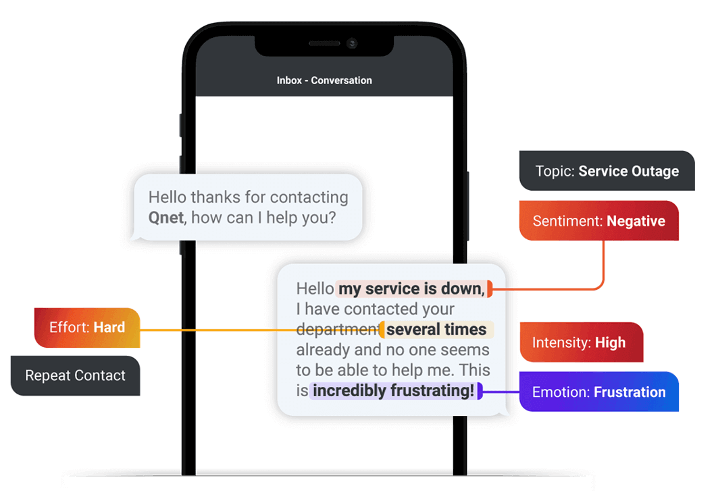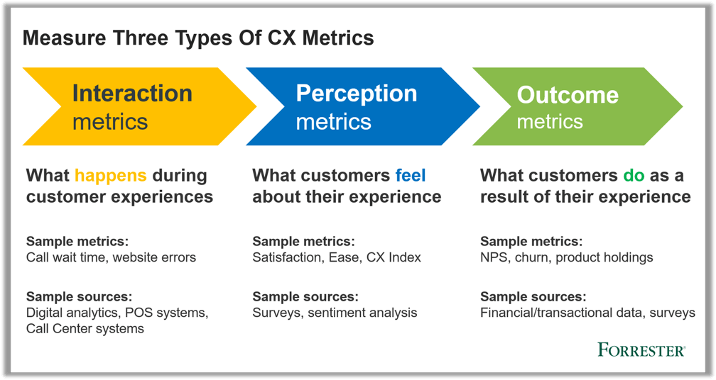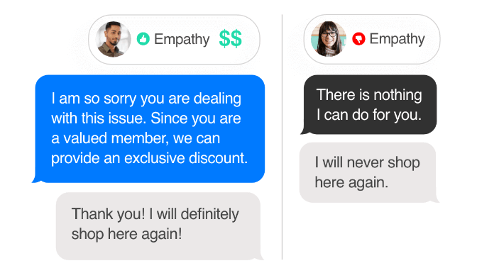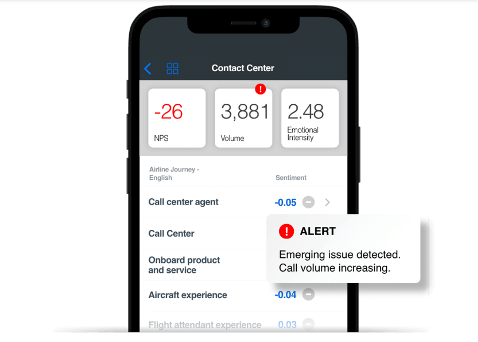What is contact centre analytics?
Contact centre analytics is the evaluation of data produced in businesses’ contact centres. It involves collecting, measuring and reporting on performance metrics, such as call handle time, customer satisfaction, and more, through the analysis of interactions between your business and your customers via your contact centre and self-service channels.
The contact centre analytics market is expected to reach $1.4 billion in 2022 because of its ability to reduce the cost of business operations at the same time as improving customer satisfaction and driving optimisation. Your customers are constantly telling you what they need and want, but without contact centre analytics, it’s hard to get a true gauge of what those are at such a large scale. Contact centre analytics can automatically bring vital customer and operational data to the surface, helping you to make predictions, take action and ultimately improve your business.
See how Qualtrics drives contact centre optimisation
Types of contact centre analytics
There are different types of analysis that can be applied to contact centre data and customer data under the umbrella of contact centre analytics. Here’s the main ones to know:
- Interaction analytics: This is the analysis of structured interaction metadata, such as agent response times, hold times, call volume, number of abandoned calls, the rate of call transfers and how quickly issues are resolved. It’s most often used to track and improve agent performance but can also be helpful to find business performance trends.
- Speech analytics and text analytics: This analysis of the unstructured interaction data of call recordings, call transcripts, live chat, email correspondence and all other interactions is made through linguistic techniques. It helps you to track more nebulous data, such as key topics, sentiment, emotions, contact drivers and more, alongside more straightforward data such as agent adherence to compliance and performance quality.

- Predictive Analytics: This analysis uses machine learning and artificial intelligence to mine customer data to predict customer behaviour, requirements and preferences ahead of time. Predictive analytics gives your business an edge when it comes to pre-empting customer needs. It can be used to streamline your contact centre operations in line with peak times, up-sell products, and flag issues before customers call for help.
- Self-Service Analytics: This type of analysis uses the data gathered from your self-service channels, such as your website FAQs, chatbots, blogs and more to understand the most frequently highlighted issues and questions. This allows you to improve your self-service options, and solve customer queries without the need for them to call up – saving both time and money.
- Customer Journey or Cross-Channel Analytics: This type of analysis uses a combination of customer journey interaction data from multiple channels alongside contact centre data for a more comprehensive view of a customer’s experience with your business. It enables you to locate points of friction, reduce customer effort, and route customers more effectively to the solutions they need. It can also aid in reducing the cost of operating contact centres by directing customers to the right self-service options.
Why is contact centre analytics so important?
Contact centre analytics can give you the insights needed to take action for great results. According to McKinsey, the effective use of centre analytics can help you to:
- Reduce average handle time by up to 40%
- Increase self-service usage by up to 20%
- Cut employee costs by up to $5 million
- Improve conversion rates on service-to-sales calls by almost 50%
- Directly improve customer satisfaction and employee engagement
Contact centre analytics is a vital part of the business optimisation process. Here are some key reasons why it should play a part of your business strategy.
It enables businesses to streamline their operations
Contact centre analytics allows organisations to keep an eye on their service metrics and improve them in a targeted way. Metrics such as average handle times, call quality, agent performance, customer satisfaction and more can be analysed at scale and insights delivered automatically, all while reducing the cost of operating the contact centre. Rather than analysing phone calls on a sample basis, 100% of call, chat, email and social media interaction data can be analysed, ensuring no insights are lost.
It helps to fill gaps in experience feedback
If your business is struggling to get customer survey responses, contact centre analytics can help you to find statistically reliable data points to reference when making key business decisions. This frontline data gives you unique business performance insights where solicited customer feedback falls short. Used in conjunction, businesses can build a powerful overview of how their customers think, feel and act, and can make strategic decisions backed by data.
It improves customer satisfaction and uncovers problems upstream
When organisations get a big-picture view of how their customer experience spans all their operations, they’re able to tailor the customer journey to better suit needs across the customer lifecycle. From online browsing to product purchase, from billing to delivery, contact centre analytics can track customer feedback at every stage and analyse it alongside other relevant contact centre data to uncover issues upstream.
Rather than guessing at the key problems customers encounter or discovering them after the fact, businesses can accurately predict the next steps they need to take across multiple areas of the business for improved customer satisfaction and better business results.
It makes your contact centre your strategic differentiator
If you create a positive service experience, customers will talk about you positively. Customer service can often be the difference between a customer staying or going elsewhere, so there’s huge value in getting it right every time. Given the choice of a competitor with a generic service experience or a highly tailored and fulfilling experience with your business’ contact centre, customers will prefer to return to spend more with your brand.
Contact centre analytics best practices
Contact centre analytics can improve results across your contact centres, but to make contact centre analytics a key source of business intelligence, you will need to deploy it effectively.
Suggested best practices are:
Ensure you use speech and text analytics to its full potential
Speech analytics and text analytics are frequently used in isolation across various parts of a business, but to be effective, a single source of truth is needed. Rather than using contact centre analytics in silos across your contact centre, sales teams, digital teams and more, all data should be analysed in a singular platform to ensure that you can coordinate strategically for the best business results. For example, call data and the data from text-based digital interactions (such as those with self-service chatbots) are often analysed separately, but this means that accurate performance metric analysis and the sharing of insights is lost.
Use the right tools
Without the right speech and text analytics and platform to bring your insights together, your contact centre analytics will be limited. Ensuring you have a powerful enough system to handle vast volumes of call and other data, as well as the ability to adapt and learn over time, is vital for optimisation. Your analysis will need to go deeper than high-level, generalised insights, and this is possible only through the use of a highly integrated, sophisticated tool.
Enable action to be taken on insights
Insights are only valuable when they are linked to action. Contact centre analytics can provide you with informative insights, but without business intelligence features that cover data integration, visualisation and the easy dissemination of insights, taking action becomes difficult.
Not only that, but the macro and micro actions that need to be taken to improve contact centre performance are lost. With the right features, you can uncover larger strategic gaps as well as individual-level problems that might be discouraging to customers. For example, a large gap might be a discount code not working and customers leaving your website as a result, increasing your bounce rate and devaluing the customer experience. A small gap might be improving a single customer’s experience by detecting frustration on a contact centre call, triggering a closed loop action that addresses the issue and improves that experience.
Go beyond word cloud analysis or high-level topic detection – use tools that give you concrete actions to take for direct improvement. At the same time, ensure your agents and other teams across your business are empowered to receive and understand insights and the role they play in taking action.
Focus on transforming the business, not making isolated performance improvements
Though improving contact centre agents’ performance or reducing call wait times will have an impact, focusing too narrowly on performance improvements means your overall business success will not be as great. Contact centre analytics, when used effectively, can help you to redesign processes and systems across your business, as well as increasing customer satisfaction by streamlining multiple touchpoints. Go beyond simply smoothing out the contact centre experience and begin preemptively changing processes to reduce costs and improve performance.
How do you use contact centre analytics to track performance?
To ensure that you’re meeting your goals for your contact centre agents and customer experience, you’ll need to develop clear KPIs and track performance over time. It’s not about drastically lowering costs at the expense of the service experience. Agents should be empowered, and scored, on their ability to solve the customer’s query in the best possible way for them and the business.
Here are some suggested methods for achieving your contact centre goals:
Developing KPIs for contact centres
Traditional metrics for your contact centres might include:
- Average time to answer
- Average abandonment rate
- First call resolution (FCR)
- Call transfer rate
- Average handle time
- Average hold time
- Average idle time / After-call work time
- Contact center agent phone etiquette
- Contact centre agent compliance
- Cost per call (CPC)
- Agent retention rate
With the addition of contact centre analytics, you are able to add this information to a wider scope of customer data for more in-depth insights. For example, you might add the following:
- Net Promoter Score (NPS): Would your customers recommend this contact centre experience to others?
- Customer Effort Score (CES): Was it easy for customers to interact with your contact centre?
- Customer Satisfaction (CSAT): How satisfied are customers with their contact centre experience?
- Contact drivers: Why has a customer reached out to this contact centre?
- Emotions: Are contact centre agents able to transform negative emotions to positive ones over the course of a customer call?
- Sentiment: Are contact centre agents able to encourage customers to have a better mental attitude towards the business or the product over the course of the interaction?
Ideally, you’re measuring:
- What happens during the customer interaction with your contact centre, on both the customer and contact centre agent side
- How your customer feels about their experience with the contact centre interaction
- What customers do next as a result of the interaction
Forrester gives a good idea of where metrics fall on this flow:

Once you’ve created a set of KPIs based not only on structured interaction data, but on the unstructured feedback your customers present to you, you’re able to better track performance.
Tracking performance of contact centre agents
Contact centre agents are often evaluated on the tangible aspects of the calls they make, and busy contact centres often don’t have the resources to track all agents’ performances across all of their calls.
Tracking the performance of your contact centre agents is made easier using software that analyses all of their interactions, not just for the metadata such as call length and agent productivity, but for the satisfaction customers report afterwards and the actions they take as a result of that interaction.
Giving your contact centre leads access to the insights provided by your contact centre analytics software means that they can see how an agent performs against the whole body, as well as how they specifically have improved customer experience across several metrics. They can also take note of what actions by specific agents have had the most impact, and incorporate new suggestions into training.

The contact centre agent experience guide
Tracking performance for customer experience
Your customer experience is greatly shaped by their experiences with your contact centres. Your contact centre gains unparalleled insights into the issues customers face, and is an excellent source of insights into customer experience and the resolution of experience problems.
Tracking customer experience performance is traditionally pinned directly to survey results such as NPS and CSAT, but by using contact centre analytics, you’re able to analyse each customer conversation for individual insights, in real-time. Rather than relying solely on customer feedback to judge your performance, you are able to see trends, understand sentiment, and pinpoint customer emotion on a grand scale.
Alongside predictive analytics, you’re able to take this information and change processes that occur before contact, then track performance after those changes have been made.
Using contact centre analytics to enhance the customer experience
Qualtrics contact centre solutions allow you to capture, analyse and integrate omni-channel data for targeted insights into the customer experience. Powered by Natural Language Understanding (NLU) and machine learning, CustomerXM is able to take structured and unstructured data across the agent and customer experience and transform it into actions for improvement across your business.

With Qualtrics, you’re able to rapidly build ROI, save on costs and create new opportunities for better customer experiences. Build customer relationships and retain business with each contact centre interaction, developing customer experience at scale.
Listen to your customers at scale with contact centre analytics